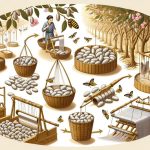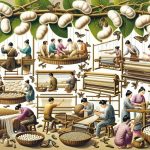Are you curious about whether all silk fabrics from Thailand are truly 100% silk? Look no further! In this article, we will delve into the origins of Thai silk fabrics and explore the production process.
We will also discuss the factors that affect the quality of Thai silk and debunk common misconceptions.
Additionally, we will provide tips on how to identify authentic Thai silk and offer guidance on caring for and maintaining these elegant fabrics.
Get ready to unravel the truth about Thai silk!
Table of Contents
The Origin of Thai Silk Fabrics
Thai silk fabrics are made from the cocoons spun by Thai silkworms. Silk production techniques in Thailand have a long and rich history, dating back thousands of years. The significance of silk in Thai culture cannot be overstated. Thai silk is renowned worldwide for its exquisite quality and intricate designs.
Silk production in Thailand begins with the cultivation of mulberry trees, which are the primary food source for silkworms. The leaves of these trees are carefully harvested and fed to the silkworms, allowing them to produce silk through their spinning process. Once the silkworms have spun their cocoons, the cocoons are carefully collected and boiled to extract the silk threads. These threads are then spun into yarn, which is used to create the beautiful Thai silk fabrics.
Thai silk holds great cultural significance in Thailand. It is often associated with royalty and is used in traditional ceremonies and celebrations. The vibrant colors and intricate patterns of Thai silk reflect the rich cultural heritage of the country. Thai silk is also highly valued for its durability and lustrous appearance, making it a popular choice for clothing and home furnishings.
Understanding the Silk Production Process in Thailand
To understand the silk production process in Thailand, you should first learn about the intricate steps involved. Thai silk is renowned for its high quality and intricate designs, and this is due to the traditional silk production techniques and weaving methods that have been passed down through generations.
The process begins with the cultivation of silk worms, which are fed a diet of mulberry leaves. The worms then spin cocoons made of silk threads, which are carefully collected and unraveled to obtain raw silk fibers. These fibers are then sorted and cleaned to remove any impurities.
Next, the silk fibers are dyed using natural or synthetic dyes to achieve the desired colors. The dyed fibers are then spun into threads using spinning wheels or machines. These threads are meticulously woven together using traditional silk weaving methods to create intricate patterns and designs.
Once the fabric is woven, it undergoes a process called degumming, where the natural gum coating on the silk fibers is removed. This process makes the fabric softer and more pliable. After degumming, the fabric is washed, dried, and ironed to give it a smooth and lustrous finish.
Factors Affecting the Quality of Thai Silk Fabrics
Factors such as the quality of the silk fibers and the dyeing process greatly affect the final outcome of Thai silk fabrics. When it comes to the color of Thai silk, there are several factors that can impact it:
-
Quality of the silk fibers: The quality of the silk fibers used in the production of Thai silk fabrics plays a crucial role in determining the color. High-quality silk fibers result in vibrant and long-lasting colors, while lower quality fibers may lead to dull or faded colors.
-
Dyeing process: The dyeing process is another important factor that affects the color of Thai silk fabrics. The skill and expertise of the dyers, as well as the quality of the dyes used, can greatly influence the final color outcome. Proper dyeing techniques and high-quality dyes ensure that the colors remain vibrant and do not fade easily.
-
Environmental factors: Environmental conditions, such as temperature and humidity, can also impact the color of Thai silk fabrics. Silk is a natural fiber and can be sensitive to environmental changes. Extreme temperatures or high humidity levels during the dyeing process may result in color variations or uneven dye absorption.
In addition to color, the durability of Thai silk fabrics is also influenced by several factors:
-
Silk fiber strength: The strength of the silk fibers used in the production of Thai silk fabrics determines their durability. High-quality silk fibers with strong tensile strength are more resistant to wear and tear, ensuring that the fabric lasts longer.
-
Weaving technique: The weaving technique used in Thai silk production also affects its durability. Traditional weaving methods, such as handloom weaving, result in tightly woven fabrics that are more durable compared to machine-made silk fabrics.
-
Care and maintenance: Proper care and maintenance also play a significant role in preserving the durability of Thai silk fabrics. Following the care instructions provided by the manufacturer, such as dry cleaning or gentle hand washing, can help prolong the lifespan of the fabric.
Exploring Different Types of Silk Fabrics From Thailand
When it comes to Thai silk, it’s important to understand its origins, the variations in silk fabric, and how to determine authentic Thai silk.
Thai silk has a rich history, originating from the northeastern region of Thailand.
The variations in silk fabric include different weaves, patterns, and colors, allowing for a wide range of options.
To ensure you are purchasing authentic Thai silk, look for the ‘Thai Silk’ label, which guarantees that the fabric was produced in Thailand using traditional methods.
Thai Silk Origins
Did you know that Thai silk fabrics come from various regions in Thailand? Thai silk production is a longstanding tradition in the country, with different regions known for their unique qualities and techniques.
Here are some interesting facts about Thai silk origins:
-
Northeastern Thailand, particularly the province of Khon Kaen, is known for its production of high-quality silk. The silkworms are fed with mulberry leaves, resulting in strong and durable silk fabric.
-
The northern region of Thailand, including Chiang Mai and Lamphun, is famous for its intricate hand-woven silk. Skilled artisans use traditional techniques to create beautiful patterns and designs.
-
The southern region of Thailand, particularly Surin and Nakhon Si Thammarat, is known for its vibrant and colorful silk fabrics. The silk is often dyed using natural ingredients, resulting in stunning hues and shades.
Thai silk fabrics are prized for their luxurious feel, durability, and vibrant colors. Each region brings its own unique touch to the production process, making Thai silk a truly special textile.
Silk Fabric Variations
Now that you know about the origins of Thai silk, let’s explore the different types of silk fabrics available.
There are several variations of silk fabric, each with its own unique characteristics. One popular type is Mulberry silk, which is known for its fine, smooth texture and high durability. Another type is Charmeuse silk, which has a glossy front and a dull back. It is often used for making luxurious clothing items like dresses and blouses. Crepe de Chine silk, on the other hand, has a slightly crinkled texture and is commonly used for flowing garments.
Silk fabric production involves a complex process. It begins with the cultivation of silk worms and the harvesting of their cocoons. The threads from the cocoons are then carefully unraveled and spun into silk yarn. This yarn is then woven into different types of silk fabrics, using various techniques such as satin weave or twill weave.
Authentic Thai Silk?
Thailand offers a variety of options for authentic Thai silk, each with its own unique qualities and production methods. When shopping for Thai silk, it’s important to be able to identify genuine silk to avoid buying fake products.
Here are some tips to help you determine if the silk you are purchasing is authentic:
- Look for the ‘Thai Silk’ label: Genuine Thai silk products will often have a label indicating their authenticity.
- Feel the fabric: Genuine Thai silk has a distinct texture that feels smooth, soft, and luxurious.
- Check the sheen: Authentic Thai silk has a natural sheen that reflects light beautifully.
Debunking Common Misconceptions About Thai Silk
If you think all silk fabrics from Thailand are 100% silk, you might be surprised to learn that there are common misconceptions about Thai silk. Let’s debunk some of these myths and explore the history of Thai silk production.
| Myth | Debunked |
|---|---|
| Thai silk is always 100% silk | Not all Thai silk is made purely from silk. Some fabrics are blended with other fibers like polyester or nylon to reduce costs and increase durability. However, authentic Thai silk is made solely from silk fibers. |
| Thai silk is only produced in one region of Thailand | While the northeastern region of Thailand, known as Isan, has a long history of silk production, Thai silk can also be found in other parts of the country. |
| Thai silk is only available in traditional designs | Thai silk has evolved over time to include modern designs and patterns. While traditional motifs are still popular, contemporary styles have also gained recognition. |
| Thai silk is always handwoven | Handwoven Thai silk is highly valued for its craftsmanship, but not all Thai silk is produced by hand. Machine-woven silk is more affordable and accessible to a wider market. |
| All Thai silk is dyed using natural dyes | While natural dyes are still used in some Thai silk production, synthetic dyes have become more common due to cost and availability. Both natural and synthetic dyes can produce vibrant and long-lasting colors. |
The history of Thai silk production dates back over 2,000 years. Legend has it that a Chinese princess brought silkworms to Thailand, sparking the start of the silk industry. Thai silk quickly gained fame for its luxurious texture and vibrant colors. Today, Thai silk remains a symbol of Thailand’s rich cultural heritage and is celebrated worldwide for its beauty and craftsmanship.
How to Identify Authentic Thai Silk Fabrics
Are you curious about the characteristics of Thai silk and how to detect fake Thai silk?
Thai silk is known for its luxurious feel, vibrant colors, and intricate patterns, making it a sought-after fabric worldwide.
However, with the rise in counterfeit products, it’s important to know how to identify authentic Thai silk to ensure you’re getting the real deal.
In this discussion, we will explore the key characteristics of Thai silk and provide you with tips on how to detect fake Thai silk, allowing you to make informed purchasing decisions.
Thai Silk Characteristics
Silk fabrics from Thailand are known for their smooth texture and vibrant colors. Thai silk production has a rich history and is renowned for its high quality.
Here are some key characteristics of Thai silk:
-
Lustrous sheen: Thai silk has a natural shimmer that adds elegance to any garment or accessory.
-
Handwoven craftsmanship: Thai silk is traditionally made by skilled weavers who use intricate techniques to create unique patterns and designs.
-
Breathability and durability: Thai silk is lightweight and breathable, making it comfortable to wear in any climate. Despite its delicate appearance, it is also known for its strength and durability.
These characteristics make Thai silk highly sought after and a symbol of luxury and craftsmanship. Whether you’re looking for a statement piece or a timeless classic, Thai silk is sure to impress with its beauty and quality.
Detecting Fake Thai Silk
To detect fake Thai silk, you can look for inconsistencies in the texture and colors of the fabric. Authentic Thai silk is known for its smooth, lustrous appearance, and it should feel soft and lightweight to the touch. Counterfeit silk may have a rough or uneven texture, and the colors may appear dull or faded.
Another sign of authentic Thai silk is the presence of irregularities in the weave. Genuine Thai silk is handwoven, so you may notice slight variations in the pattern and spacing of the threads.
Additionally, authentic Thai silk is often made from natural fibers like silk worms’ cocoons, while fake silk may be made from synthetic materials.
Caring for and Maintaining Thai Silk Fabrics
You should always follow the care instructions to properly maintain your Thai silk fabrics. Caring for silk garments is essential to ensure their longevity and keep them looking their best.
Here are some tips to help you care for and maintain your Thai silk fabrics:
-
Hand wash: It is best to hand wash your Thai silk garments in cold water with a gentle detergent. Avoid using bleach or harsh chemicals as they can damage the delicate fibers of the silk.
-
Air dry: After washing, gently squeeze out the excess water from your silk garments and lay them flat to air dry. Avoid wringing or twisting the fabric, as this can cause it to lose its shape and stretch.
-
Avoid direct sunlight: Silk fabrics are prone to color fading when exposed to direct sunlight for extended periods. To prevent color fading, store your Thai silk garments in a cool, dark place or use UV-blocking curtains or blinds to shield them from the sun.
Following these care instructions will help to preserve the beauty and quality of your Thai silk fabrics, ensuring that you can enjoy them for years to come.
Conclusion
In conclusion, when it comes to Thai silk fabrics, not all fabrics are 100% silk. It’s important to understand the origin and production process to ensure the authenticity of the fabric.
Factors such as weaving techniques and dyeing methods can also affect the quality of the silk.
By debunking common misconceptions and knowing how to identify authentic Thai silk, you can make informed decisions when purchasing and caring for your silk fabrics.
Remember to handle them with care to maintain their beauty and longevity.
- Who Owns the Gore-Tex Brand? - July 2, 2025
- Does Using a Peet Dryer Ruin Gore-Tex Boots? - July 2, 2025
- What Is the New Gore-Tex Epe Membrane? - July 2, 2025





